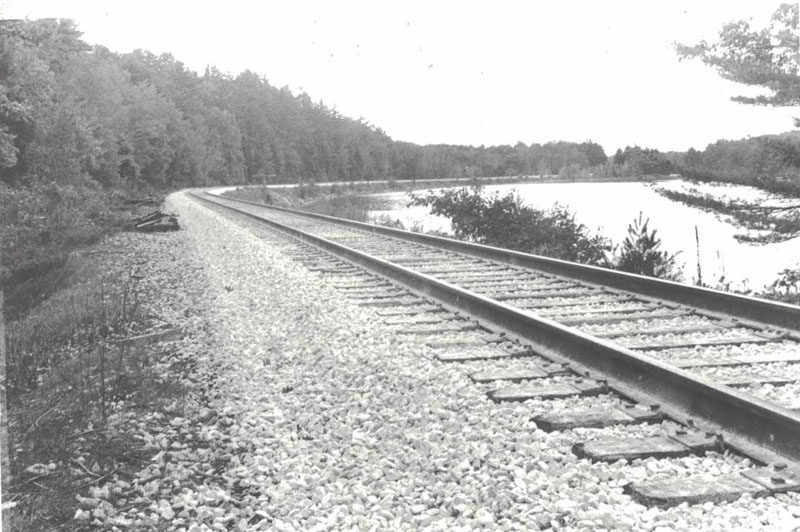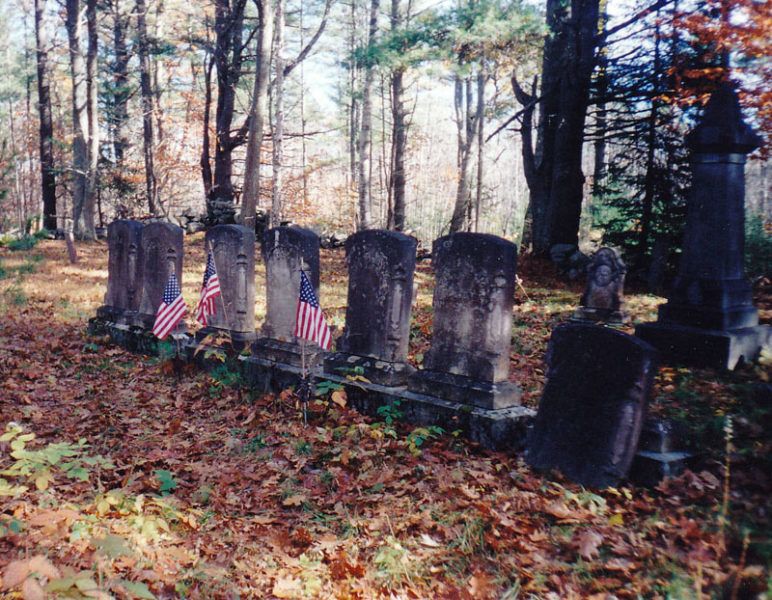
The railroad crosses the Sheepscot River near the Sherman home in Newcastle. (Photo courtesy Newcastle Historical Society Museum)
In February 2002, Roger Sherman, then approaching 90, gave an interview to Art Mayers about growing up in South Newcastle.
According to Roger, things had not changed much since he was a boy. “Unlike other parts of town, the area along the Station Road and Cochran Road has remained farmland where some traditional activities such as the raising of livestock and the gathering of firewood still go on,” he said.
This section of land on the west side of Route 1 bordering on the Sheepscot River is an often forgotten part of our town.
Sherman was born there, Jan. 25, 1913, the oldest son of Fred and Lena Sherman. He grew up on Station Road.
After the Civil War, the country became interested in railroads. The first train to Bath came in 1849, but it would be more than 20 years before a route would be made to Rockland. From Wiscasset, the train crossed the Sheepscot River under a covered bridge and ran through Edgecomb and Newcastle, near where the Shermans lived.
Roger’s father, Fred, was station clerk at the Newcastle station there. The accompanying photograph shows the railroad crossing the Sheepscot River where Roger lived. At the station there was a waiting room with a platform and a ticket office. It was called a flag station which meant the train did not stop every time. It stopped if there were items or people to get off.
A green and white flag was used to signal the train to stop if there were items or passengers to pick up. The tracks still run through the area but the station is gone and train service almost gone. There is no passenger service and freight trains are few and far apart.
Roger Sherman attended the one-room Beech Hill School. One day he tells, a coal-fired steam shovel, on its way to work on Route 1, came up the hill by the school spewing smoke and ash. It set the roof of the schoolhouse on fire. They put the fire out easily but, he went on to say, the building burned to the ground in later years.
Reading this surprised me for I have a picture of the Beech Hill School and was told it was still standing.
Roger went to Lincoln Academy for his high school years. “I rode the train, then by horse and buggy, and the last part by car,” he said.
He graduated from Lincoln Academy in 1929. That was the era when students coming to school either by horse or motor vehicle would have been common.
What was different for Roger, and other students in South Newcastle, Edgecomb, Nobleboro, and Damariscotta Mills, was they came to school by train. For years, many students came from both the south and the north, getting off at the train station just down the hill from Lincoln Academy. Only after World War II did this way of travel to school become impossible.
While Roger was growing up, mail was delivered by Mel Mason from the Edgecomb Post Office. He rotated the use of three horses to make the route. Mason also developed a crude snowmobile that he sometimes used when it was not broken down. Mason was instrumental in later years in having Sherman Lake named after Roger’s father.
In later years I boarded in the same house as Mel Mason for a winter, so I got to know him quite well. I was a freshman at Lincoln Academy and I and my sister would come down from our father’s farm in Jefferson to stay during the school week so it would be easier to get to school.
This was an old out of town custom and as it was during World War II when cars, tires, and gasoline were scarce, it was what we did. We boarded with Mrs. Adessa Boudin on Glidden Street. She was a widow and kept house for her daughter, Mrs. Thelma Clark.
Mel, as we called him, was an old gentleman, by then retired from mail carrying. He still had his place in Edgecomb, but he spent the nights in Newcastle. After we had breakfast he would take his lunch, get in his car (no horses any more) and head for his house in Edgecomb where he would putter on his hobbies during the day.
We would all return in the late afternoon for supper and a comfortable evening. Mel had his special chair right next to Mrs. Boudin’s coal fired cooking stove where he was warm and comfortable.
Roger’s part of Newcastle had a post office in the areas near the old railroad station on Station Road. It was under the Edgecomb delivery. Only years later, when the government changed routes so everyone in a town would have the same post office did that area become part of the Newcastle postal routes.
In 1942, after several years at home, Roger entered the Army. This was World War II and all the men were in great demand. He spent time in Virginia, Texas, and the Carolinas. Because of his typing skill he became an assistant to a medical team.
“I even helped deliver a baby once,” he said.
After the Army, he applied for a job with Central Maine Power at the time Mason Station was being built in Wiscasset. He was given a job in Lewiston, but ended up with a desk job in Augusta.
On June 7, 1947 he married Merlita Mckay from Malden, Mass. At first, they lived in Augusta. It was there their only child, Hugh, was born. In 1988 they moved back to the Cochran Road in Edgecomb.
Roger liked to talk about his life and the area. If he could join us now I am sure he would still say the area has remained farmland. The other day, as I had the time, I drove over Roger’s road. I turned in at Station Road, drove past the road to the island. There are new houses along the way. I swung by the road to the Malcolm cemetery, Trails End Road, Brick Hill Road and back to Route 1, over the Cochran Road.
It was easy to see why he loved it there, but I am sure he would say it is still a farming area with rural activities.

The Malcom Cemetery on the Station Road Extension in Newcastle (Photo courtesy Newcastle Historical Society Museum)



